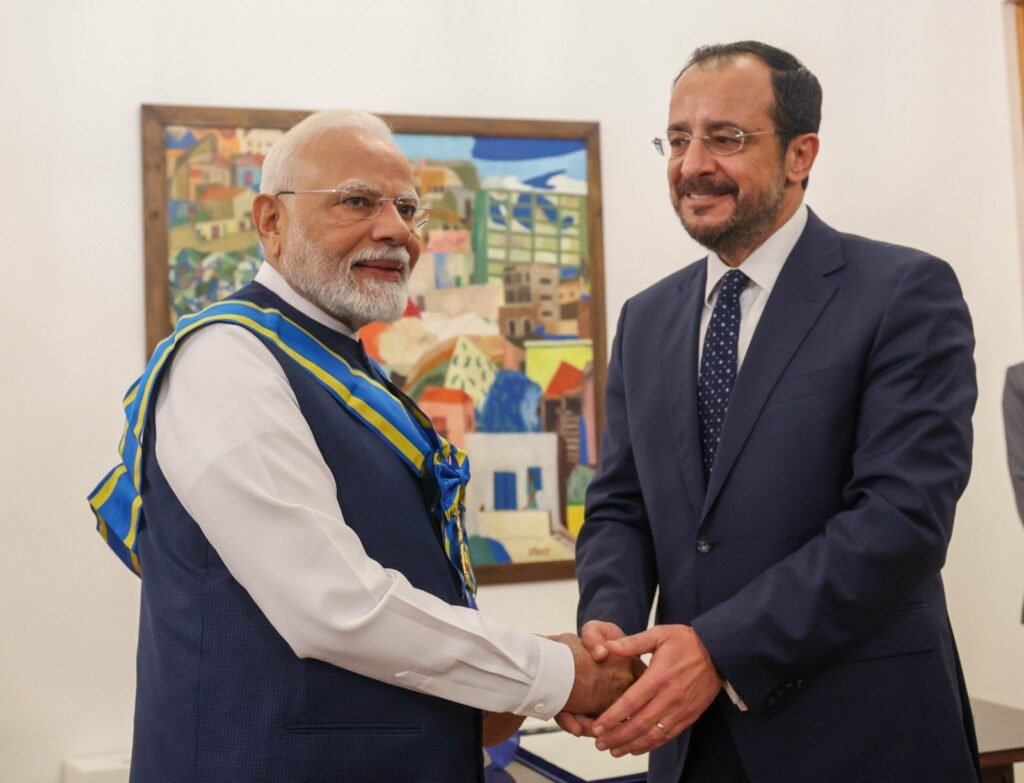
- Modi signalled his intention to engage with European and Mediterranean partners who share India’s concerns over regional war-mongering.
- The visit also promoted Cyprus as a potential player in the India–Middle East–Europe Economic Corridor (IMEC), a flagship New Delhi initiative to diversify supply chains away from that of China’s Belt and Road.
- Modi’s pledge of technical assistance for Cypriot gas-to-liquids research underlines Delhi’s intent to translate diplomatic goodwill into tangible partnerships.
- PM Modi’s Cyprus visit worked out to be a skilful blend of symbolism and substance.
Prime Minister Narendra Modi’s two-day visit to Cyprus on June 15–16, 2025, marked the first trip by an Indian leader to the Mediterranean island in over two decades. Beyond the ceremonial optics of state honours, the Grand Cross of the Order of Makarios III, this engagement carried layered strategic connotations. Most notably, it was a clear poke at Ankara, given Turkey’s historic occupation of northern Cyprus and its recent provocation with Pakistan during Operation Sindoor. In selecting Nicosia as his first port of call after the border flare-up with Pakistan, Modi signalled his intention to engage with European and Mediterranean partners who share India’s concerns over regional war-mongering.
Cyprus’s geographical predicament, as a divided island with a UN-controlled buffer zone, added even further gravitas to Modi’s itinerary. Accompanied by President Nicos Christodoulides, he travelled to the Green Line in Nicosia, implicitly reiterating India’s commitment to Cypriot sovereignty and aversion to unilateral territorial occupation. The “Turkey factor” reverberated not just on the eastern Mediterranean but also in India’s internal narrative, where strong stands against cross-border bellicosity enjoy widespread support.
The visit also promoted Cyprus as a potential player in the India–Middle East–Europe Economic Corridor (IMEC), a flagship New Delhi initiative to diversify supply chains away from that of China’s Belt and Road. Modi along with Cypriot business leaders participated in business roundtable meetings in Limassol where the two sides discussed potential for the island to function as a transshipment hub, which would cater to Indian port requirements with a single point and allow Indian goods to be transported right up to Europe through a combination of sea and rail links. For India, which imports over 90 per cent of its container traffic through maritime routes, such a corridor promises resilience against chokepoint disruptions and enhances its “Act East” vision by extending into Europe.
Parallel to corridor talks, Modi and President Christodoulides reiterated their mutual ambition to seal an India–EU free trade agreement by year-end 2025. Cyprus’s forthcoming EU Council presidency in early 2026 positions it as a critical advocate for swift ratification in Brussels. As Modi noted, “We expect the FTA to open vast new vistas for Indian SMEs and high-tech exports,” while Christodoulides pledged active Cyprus support during its presidency. Yet, Brussels must reconcile internal sensitivities, particularly French and German concerns over market access reciprocality, before final signatures can be exchanged.
Energy cooperation became yet another cornerstone. Cyprus, with new offshore natural gas prospects, is at the crossroads of Eastern Mediterranean energy politics involving Greek, Israeli, Egyptian and Turkish players. Indian companies have started to look at taking equity stakes in Cypriot blocks in a bid to diversify their fuel sources as global prices remain fickle. Modi’s pledge of technical assistance for Cypriot gas-to-liquids research underlines Delhi’s intent to translate diplomatic goodwill into tangible partnerships.
Beyond commerce and energy, Cyprus has been a steadfast supporter of India’s multilateral objectives. Since 2002, when Prime Minister Atal Bihari Vajpayee secured Nicosia’s backing for India’s UNSC permanent membership bid, the partnership has deepened. Cyprus’s endorsement of India’s NSG accession and civil nuclear deal with the United States amplifies New Delhi’s case within forums often resistant to expansion. Modi’s visit reaffirmed these alignments, with both leaders expressing intent to coordinate positions in international organisations.
However, the Cyprus trip also highlights the limitations that India must navigate. First, IMEC is an embryonic idea, and infrastructure deficiencies exist in the Middle East, and political instability within transit states persists. Whether the grand and ambitious corridor plans become freight trains and shipping lines depends on India’s capacity to leverage financing, provide security along the route, and align regulatory regimes. Second, Cyprus’s weak economic position, with NPL ratios still some of the highest in the EU, could compromise its ability to assume the burden of major logistics investments in the absence of significant EU or third-party backing. Third, the “Turkey factor” is good for rhetoric, but could also run the risk of offending Ankara as India tries to carefully navigate the burgeoning economic relationship with the private sector in Turkey, particularly in textiles and the automotive component space.
Furthermore, the market access that the free trade agreement promises must be set against potential domestic sensitivities in India’s agricultural and dairy sectors, where European competition could impact smallholders. India will have to use calibrated negotiating strategies to safeguard sensitive lines while winning concessions for its pharmaceuticals and IT services.
So, in all, PM Modi’s Cyprus visit worked out to be a skilful blend of symbolism and substance. It reinforced India’s position as a global balancer for sovereignty, advocating diverse connectivity and consolidating support for multilateral aspirations. But the true test will be to translate diplomatic communications into fully functional corridors, energy projects and trade agreements. It could be so if New Delhi and Nicosia can work out a realistic roadmap based on stagewise investments, strong risk-mitigation mechanisms and transparent policy frameworks, Cyprus can indeed become a model for India’s larger engagement with Europe. Until then, Cyprus will serve as an experimental ground for the potential and pitfalls of 21st-century geoeconomics.
References:
- Reuters: “India expects EU trade deal by year end as Cyprus pledges support”– detailing the India–EU FTA timeline and Cyprus’s backing during its 2026 EU presidency
- Reuters: “India Prime Minister Modi visits Cyprus to advance trade corridor plans” – covers the India–Middle East–Europe Corridor discussions in Nicosia and Limassol.
- India Today: “Message for Turkey? Why PM Modi’s first post-Operation Sindoor trip is to Cyprus” explores the Cyprus visit as a strategic statement to Ankara.
- Times of India: “’ Not an era of war’: PM Modi declares amid West Asia tensions; highlights growing ties with Cyprus” – highlights Modi’s visit to the buffer zone (Green Line) and the emphasis on regional stability
- Firstpost: “PM Modi in Cyprus: Why this Turkey rival matters to India” – gives insights into offshore gas energy diplomacy, trade ties, and geopolitical signalling.
Shashank is a Master’s student in Diplomacy, Law, and Business at O.P. Jindal Global University. He is also a researcher and coordinator at the Center for Global South and the Center for Southeast Asian Studies. His research interests include Southeast Asia, Chinese foreign policy, India’s Act East Policy, and global security dynamics. Views expressed are the author’s own.
